For most engineers, sync-ups are an essential part of their daily agenda. They allow teammates to discuss progress, address pain points and simply connect with each other. Yet, these team huddles are not always as productive and engaging as they should be, so it’s up to leaders to make sure their teams stay on track during sync-ups.
With the right strategies, leaders can help their teams get the most out of their daily meetings. By setting goals, maintaining structure and encouraging participation from each team member, leaders can turn these often aimless huddles into meaningful moments for collaboration.
Given the fact that many teams are working remotely, connection among team members is especially important. For some leaders, this may mean setting aside a few minutes for casual conversation at the start of each sync-up. For others, this could simply be a matter of asking team members to keep Zoom’s video feature on throughout the meeting.
Whether you’re a self-proclaimed “scrum purist” or an Agile rule-breaker, successful syncs don’t have to be a stretch. By taking simple steps, leaders can ensure their teammates feel both empowered and informed at the end of each huddle, setting the stage for a productive week for the entire team.
Built In caught up with 42 tech leaders to learn how they’ve mastered the art of the successful sync-up.
Tips for Successful Daily Stand-Up Meetings
- Keep meetings short and structured
- Allow time for questions at the end of each meeting
- Take unresolved issues or longer discussions offline
- Make sure everyone has a chance to speak
BigCommerce
Erik Christensen
ENGINEERING MANAGER

BigCommerce is on a mission to “revolutionize commerce” with its open SaaS platform that empowers e-commerce businesses to build, innovate and grow their brands.
Engineering Manager Erik Christensen shared how he’s tweaked daily huddles for remote life to allow for organic conversation and ad-hoc problem-solving.
What does a typical sync-up look like for your team, and how do you structure those meetings to ensure they're as effective/productive as possible?
The core of our daily standup is similar to many Agile companies, with each member of the team discussing what they’ve completed, what they’re working on and any blockers they’ve encountered. We don’t follow the strict “only talk about what you completed and will complete” rule, as I actually find updates on what people are currently working on to be very valuable, especially in a remote environment. We keep this meeting to 15 minutes and generally postpone any discussions until after the standup.
What’s one thing you’ve done to improve the effectiveness of your stand-up meetings? What were the results?
While we haven’t tweaked the core formula of our standups much, we’ve changed what happens before and after the meeting. With less face-to-face contact, the daily stand-up has actually grown in importance, as it now serves a similar role to morning coffee runs in the office. People are actually arriving early to our stand-up meetings just to chat with their co-workers, which allows for a much less abrupt start to the day. Making sure there aren’t any recurring meetings booked prior to the standup allows for this to happen organically.
Similarly, we’ve seen a need for more small, ad-hoc meetings after the standup. Typically, there will be one or two friction points we notice during people’s updates, and we use the time after the standup to resolve these issues. These may be brief debates on what technical approach to take or clarification of product requirements. Having these discussions immediately after the standup allows us to resolve them quickly and naturally invites other team members who are curious about the issue to hang around for a few minutes after the meeting to hear what other team members are working on.
With less face-to-face contact, the daily stand-up has actually grown in importance.’’
Sync-up meetings can have a tendency to feel repetitive or boring after a while. What’s one strategy you’ve found to be critical for keeping employees engaged throughout these meetings?
A few months into our fully remote situation, I noticed the team was beginning to feel a bit more fragmented than usual. We were working on a number of projects concurrently, which resulted in most engineers having solo projects that didn’t intersect much with anyone else’s work. Without the office environment, ad-hoc discussions about other people’s work became far less common, and isolated silos of domain knowledge were growing. As a result, our standups started to feel like dry, rote status updates.
One of the engineers on my team suggested doing a design workshop to break things up and get the team more involved. Our team’s designer planned and ran a three-day workshop roughly based on the design sprint model.
We used Miro to visually brainstorm instead of the whiteboards we normally have availible in office. The team ended up loving the tool, and we actually found it better for large group collaboration. As an added benefit, it’s a lot easier to keep the artifacts from the workshop easily accessible now that we don’t have to store enormous rolls of butcher paper with Post-its all over them.
Sendoso
Qaseem Shaikh
CHIEF TECHNOLOGY OFFICER

Sendoso aims to help companies more closely engage with buyers and consumers. The company helps sales, marketing and CX teams engage at strategic points throughout the customer journey, which drives more pipeline and revenue.
Chief Technology Officer Qaseem Shaikh shared how his team prefers structured standups and why it's important to have everyone take turns leading sync-ups.
What does a typical sync-up look like for your team?
Anyone can start each standup. After giving their update, each person nominates who will go next. After weekends and holidays, people usually share fun stories and updates about what they did. Every standup typically covers what each person worked on the day before, what they’re working on that day and any blockers that may have come up as well as any callouts.
What’s one thing you’ve done to improve the effectiveness of your sync-up meetings? What were the results?
We’ve adopted three strategies: keep updates short, take longer discussions offline and allow team members to give asynchronous updates on Slack if they can’t make the meeting.
As a result, each team member stays within the time limit and has greater flexibility while continuing to have deeper conversations when necessary.
Take longer discussions offline and allow team members to give asynchronous updates on Slack.
What's one strategy you’ve found to be critical for keeping employees engaged throughout these meetings?
One thing that has helped us is that we don’t have a set order in which people lead each sync-up. It keeps everyone engaged, considering they know they could be nominated next.
Planet
Kattia Flores Pozo
ENGINEERING MANAGER, SPACE OPERATIONS
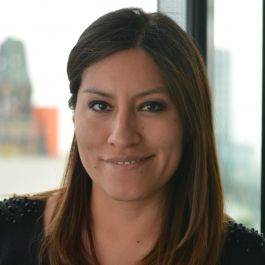
Planet believes life on Earth can be better understood from space. The company designs, builds and operates Earth-imaging satellites, which deliver a dataset of geospatial imagery used to help solve some of the world’s critical problems, like forest clearing and natural disasters. Every three or four months, Planet launches new satellites into orbit.
Engineering Manager Kattia Flores Pozo discusses how her team uses sync-ups to address important issues and foster team spirit — even from across time zones.
What does a typical sync-up look like for your team?
Since we are a geographically distributed team, sync-ups are very important, especially considering that we need to make concessions to match different time zones. At the start of the week, I sync with the lead of our team in San Francisco, and we decide on topics that need to be discussed between both groups. We inform the team beforehand and ask if there are additional topics they want to bring up during the meeting so we can structure and prioritize an agenda. During the meeting, one person will lead the discussion on each topic, and we make sure to capture actions and follow-ups at the end of the discussion.
Prior to any sync-up meeting, I always try to make sure I provide a list of bullet points of the topics I wish to cover, any additional documentation needed beforehand or links to resources that will be used in the meeting, so people have time to review.
What's one thing you've done to improve the effectiveness of your stand-up meetings?
We give standups aggregated value. When we were all working together in the office, standups were mostly used to report what each of us was going to work on that day. Other discussions or asks from team members would naturally occur in person. When we switched to working remotely due to the pandemic, the stand-up meetings became a time where the team had a chance not only to report statuses but also bring up discussions that needed to trigger action within the team. These meetings also allow everyone to check on each other and foster team spirit, which is especially important if we have colleagues starting remotely.
It’s important to make sure everyone gets the opportunity to discuss their work during sync-up meetings.’’
What’s one strategy you’ve found to be critical for keeping employees engaged throughout these meetings?
To keep everyone engaged, it’s important to make sure everyone gets the opportunity to discuss their work during sync-up meetings. If there are immediate topics that need to be discussed, we will prioritize that, but we make sure we have a list of mixed upcoming topics. In space operations, we are always working on multiple topics and issues at the same time, so discussions are never repetitive.
Rippling
Michael Sung
ENGINEERING MANAGER

Rippling is on a mission to “free companies from the burden of administrative work.” The company’s platform allows organizations to manage and automate all of their people operations, from onboarding to payroll and benefits.
Engineering Manager Michael Sung shared why his team thinks of sync-ups as forward-thinking and customer-focused, rather than task-based.
What does a typical sync-up look like for your team?
Nearly every day of the week, we have a standup related to the product we work on. The standup is customer-focused and cross-functional. Our product development, support, sales and implementation teams all participate. While product development and support are present every day, other teams can optionally jump in or out as needed. We’re also a remote group, so the meeting is over video call. Our participants are based in places ranging from California to Florida. We structure the standup as a forward-facing, round-robin meeting, in which everyone talks about customer priorities and how these priorities affect the day’s plans.
What’s one thing you’ve done to improve the effectiveness of your stand-up meetings?
I think the most effective improvement to our standups has been something we actually changed outside the standup. We increased the frequency of our longer-term roadmap planning. When discussing priorities during standups, some requests end up being larger features that need to be planned in a separate roadmap meeting. Early on, we did roadmap planning at a quarterly cadence. The three months spent waiting for roadmap updates would often feel too long, and people would get out of sync on the roadmap, leading to longer, follow-up conversations. Once we rescheduled our roadmap meetings to occur monthly, we were able to more closely connect the roadmap to the customer and provide a stronger focus on the day-to-day during our standups.
Discussions are forward-facing and customer-focused rather than backwards-facing and task-focused.’’
What’s one strategy you’ve found to be critical for keeping employees engaged throughout these meetings?
I think we have strong engagement in our standups because discussions are forward-facing and customer-focused rather than backwards-facing and task-focused. By connecting how changes to the product affect our customers, we keep everyone in the standup engaged and focused on freeing smart people to work on hard problems.
HomeLight
Mike Abner
VICE PRESIDENT OF ENGINEERING

The home buying and selling process is often unnecessarily stressful. HomeLight wants to change that. The company analyzes millions of real estate transactions to help home buyers and sellers find the right agents in their area.
Vice President of Engineering Mike Abner shared why he lets individual managers and team leads decide how to structure sync-ups.
What does a typical sync-up look like for your team?
As a vice president, it’s nearly impossible for me to attend our team’s many daily standups. At HomeLight, the individual team managers are free to run their standups in the way that works for them and their teams without significant oversight. I actively encourage our team to define and host standups that work best for them. We’ve found this to be an incredibly helpful approach, especially since our worlds have been turned upside down due to COVID-19. The goal of each standup is to tackle blockers or pain points, support team cohesion and keep our spirits high while working remotely.
What's one thing you've done to improve the effectiveness of your stand-up meetings?
I’ve found it effective to encourage each manager and team to lead standups that work for them rather than relying on a companywide template. As a result, the standups have naturally evolved to be as effective as possible for each team.
There are a few examples of how teams have done this. For instance, Marty, an engineering manager in our Seattle office, has incorporated a “Guess which band t-shirt Charlie is wearing” game at every standup to keep things fresh. Charlie, an avid guitar player and musician, has an extensive collection of band t-shirts. At the beginning of each standup, he keeps his Zoom video off, answers a few questions from the team, plays a riff on the guitar from one of the band’s songs and then has the team try to guess the band before kicking off the typical stand-up rituals.
Steve, an engineering manager in our Scottsdale office, has his team post their short status updates in a dedicated Slack channel 30 minutes before their stand-up meeting, so they can use their stand-up time to get right to the pain points and use the rest of the time as an informal team event where they can chat about life, world events or what they’re currently binge-watching.
Standups in a remote work world can be a time for some unstructured team-building.’’
What’s one strategy you’ve found to be critical for keeping employees engaged throughout these meetings?
In the age of COVID-19 and remote work, we’ve tried to make each standup more than just a super efficient check-in and, instead, use each one as a chance for team-building and cohesion. This was less important when each team was in an office together, but in a Zoom-focused world, you miss those spontaneous moments in the day that help build relationships. Standups in a remote work world can be a time for some unstructured team-building. We’ve tried to take advantage of that without it feeling forced.
Vungle
Renee Juszczak
SR TECHNICAL PROGRAM MANAGER

Vungle wants to transform the way people discover and experience apps. The company partners with app developers and publishers to monetize their apps through ad experiences, thus helping them increase engagement and drive revenue.
Senior Technical Program Manager Renee Juszczak told us why it’s important to leave a few minutes at the end of every sync for open questions.
What does a typical sync-up look like for your team?
Every day, we have 15-minute standups. I am currently working with multiple teams in different time zones. The high-level meeting structure we follow starts with each team member providing an update followed by time at the end for questions. I kick off each standup by sharing my screen via Google Meet and presenting our current sprint board in Jira. Following the same order each day, I ask each developer for their update, which covers what they have been working on or completed over the past day, their plan for the current day and any blockers they may have. I then move on to QA for their updates and then, finally, product. The sprint board I present in standups has the ability to filter work specific to each team member. At times, I find it helpful to use these sprint board filters to show the tickets per team member as they provide their update.
What’s one thing you’ve done to improve the effectiveness of your stand-up meetings?
It is inevitable that team members will want to ask each other questions, especially while working remotely. Standups should be a reliable daily meeting that everyone on the team attends. With everyone already on a call together, using the last several minutes to address open questions is an effective way to quickly help team members. If open questions cannot be resolved quickly, a separate meeting can be scheduled to sort through the issues. However, make sure you do not mix Q&A time with individual team updates, as this will derail your standup and cause the meeting to exceed your scheduled time.
Maintain a consistent structure and set aside time to openly discuss questions.’’
What’s one strategy you’ve found to be critical for keeping employees engaged throughout these meetings?
Efficient and engaging standups can be created by maintaining a consistent structure and setting aside time to openly discuss questions.
Expedia Group
Norman Fletcher
SENIOR DEVELOPMENT MANAGER
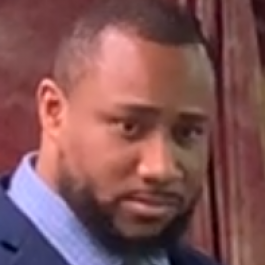
Expedia Group helped define the travel industry upon its inception in 1996. Today, the company boasts a portfolio of travel brands including Hotels.com, Travelocity and Vrbo.
Senior Development Manager Norman Fletcher shared why it’s important to shake up the routine of sync-ups to keep team members engaged and focused, even if it’s as simple as changing the order that everyone presents their work.
What does a typical sync-up look like for your team?
We are a global company with offices on six continents and personnel collaborating from multiple locations. This requires a flexible work schedule to accommodate the various time regions, especially given COVID-19, since most employees are working from home.
Currently, for remote sprint ceremonies, we use messaging tools like Bluejeans, Slack and StatusHero integrated with project management tools like Jira and GitHub to compile team stand-up activities and code check-in statuses into a single report we can review and share. This helps teams retain focus by granting continuous clarity on accomplishments, intentions and blockers across workflows. For every meeting, particularly standups, we decide on frequency, a structure and a time cap. We ask every team member to take turns leading a meeting. Individuals create agendas and talking points, all with an emphasis on brevity. Many companies have embraced stand-up meetings because the format keeps gatherings concise.
WHAT BEST PRACTICES DOES YOUR TEAM FOLLOW TO MAKE STANDUPS MORE EFFECTIVE?
- Create an agenda in advance and set objectives for the meeting. Invite only those who need to be there so everyone else can have dedicated work hours.
- Share your screen while presenting. This keeps everyone on the same page and allows them to see exactly what we are talking about.
- Stay on track. Check in throughout the meeting to make sure we are meeting the objectives and accomplishing what we set out to do.
- Start and end on time.
- Include everyone. Open-ended questions can lead to many people talking at once, so make sure to promote turn-taking. Let team members know they can participate, but give them time to formulate their responses. When asking questions, be direct by calling people out by name.
What’s one strategy you’ve found to be critical for keeping employees engaged throughout these meetings?
When people know what to expect, they tend to lose interest. Because daily stand-up meetings are routine by nature, you need to vary the routine in order to keep people engaged. For example, if a typical stand-up meeting agenda includes going around the room anti-clockwise and hearing from each person, we put everyone’s name in a hat and draw to see who goes next or have a daily secret word to keep people listening closely.
Quantcast
Oscar Gothberg
HEAD OF ENGINEERING, DATA PLATFORM

Quantcast aims to simplify advertising on the internet through AI. The company’s audience behavior platform directly quantifies over 100 million web and mobile destinations.
Head of Engineering Oscar Gothberg weighed in on why it’s crucial to be “the stand-up participant you want others to be.”
What does a typical sync-up look like for your team?
In our daily standups, team members do a quick round of status updates where each of them shares what they are currently working on, any obstacles they’re facing and other important information. Each person’s update is quick and to the point.
The standup is an opportunity for everyone on the team to stay updated on what's going on, ask questions, ask for (and offer) help and receive early warning about anything going pear-shaped. Sharing daily tasks out loud also helps people keep themselves accountable.
What’s one thing you’ve done to improve the effectiveness of your stand-up meetings?
If a conversation gets long-winded, I suggest the participants take it offline. The standup is democratic in the sense that everyone participates on an equal footing. This means that if the meetings are unfocused or ineffective, you can lead by example to make them better. Be the stand-up participant you want others to be.
Be the stand-up participant you want others to be.’’
What’s one strategy you’ve found to be critical for keeping employees engaged throughout these meetings?
Keep them brief. Standups are for letting your team know what you’re about to do, or call out that you need help with something. They’re not used to discuss any one topic at length.
Also, start on time. Standups are frequent and light-touch, and having a team member join late or miss one once in a while shouldn’t be the end of the world. So if someone is late, just start and finish without them, if necessary.
Milyli
Jacob Malliet
TECH LEAD

Tech Lead Jacob Malliet said casual “water-cooler talk” helps his team warm up at the start of virtual meetings at Milyli, a software development firm that builds custom software solutions for legal professionals. From there, Malliet allows each person two to three minutes to discuss their priority items and announce soft deadlines. As a leader, Malliet said tracking those deadlines helps identify if the project is on course or if there will be problems ahead.
What does a typical sync-up look like for your team, and how do you structure those meetings to ensure they're as effective/productive as possible?
A virtual stand-up for us starts with “water-cooler talk.” While we’re remote, we do Slack calls. We start with our highest priority items and then discuss the previous day’s accomplishments. Each person gets about two to three minutes for their key updates depending on how many people are attending.
Extend the meeting if necessary; there shouldn’t be a rush for the meeting to end early.”
What’s one thing you’ve done to improve the effectiveness of your stand-up meetings?
We’ve learned to track and call out soft dates a lot more often. Watch for when any early estimates start to slip or fall behind early in a project. If you miss those first target dates, even if they’re soft or planning-related, it usually indicates there will be problems ahead. Working remotely, you have to listen and track everything a little more closely.
What’s one strategy you've found to be critical for keeping employees engaged throughout these meetings?
Extend the meeting if necessary; there shouldn’t be a rush for the meeting to end early. Instead, make space for those offline discussions that used to happen in smaller groups or one-on-one. While remote, those conversations need to be facilitated because you don’t have the visual or physical cue anymore. It breaks the traditional pace standards of stand-ups to allow for extraneous topics, but as long as it’s in our allotted time, we’ll tend to circle back for more details before dismissing the group.
Kenna Security
Alana Anderson
ENGINEERING MANAGER
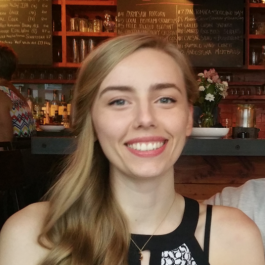
Alana Anderson, an engineering manager at Kenna Security, said sync-ups are like a yoga practice in that a little repetition can go a long way. When considering change, solicit feedback from the team for suggested improvements. From there, changes should be incremental to allow for quick adjustments.
What does a typical sync-up look like for your team, and how do you structure those meetings to ensure they're as effective/productive as possible?
The purpose of stand-ups is to ensure team communication is present around any progress made toward the team’s sprint goals.
One of our methods includes a walkthrough of our team sprint board. The engineering manager or scrum master will drive this session by sharing their screen on a Zoom call, guiding their team through in-progress items. The idea here is to gain insight into the progress made with each engineer in regards to their assigned tasks, such as a brief summary of what the task entails, a status update or any impediments that are blocking the individual or team.
This method should take no longer than 10 to 15 minutes. It acts as a visual guide and reminder for the team and how they’re making progress in their sprint.
What’s one thing you’ve done to improve the effectiveness of your stand-up meetings?
Just because one method serves its purpose well doesn’t mean we can’t explore improvements. Seeking feedback from your team helps immensely with this.
In our stand-ups, we occasionally have a different engineer take the driver seat. Doing so helps build leadership skills for the individual and grants the team a change in pace and scenery. A fresh voice or guiding round-robin style can reinvigorate the team.
Unpopular opinion: stand-ups are meant to be repetitive.”
What’s one strategy you’ve found to be critical for keeping employees engaged throughout these meetings?
Unpopular opinion: stand-ups are meant to be repetitive. For your team to be well-coordinated and in-sync, a little repetition goes a long way.
Same place, same time, same agenda. If you’ve ever taken yoga classes, it’s very similar. To alleviate the “boring” feeling, exercise the feedback from your team. Trying new things should be done incrementally; test out the hypothesis and make adjustments when needed. Ultimately, repetition should pave the way to establish stand-ups as a daily ritual for your team.
An example of a piece of feedback that came through a retro session was taking one day of the week and not hosting the stand-up. Simply giving that time back to your engineers to focus can be a game changer to the productivity of the sprint.
Peapod Digital Labs
Brian Theise
EXECUTIVE LEAD, TECHNOLOGY

At grocery delivery platform Peapod Digital Labs, Executive Lead Brian Theise said weekly 30-minutes huddles across the company are an effective way to show off projects and celebrate goals and milestones. Since the company is remote, Theise said he encourages everyone to turn on their video and utilize a fun background to create a sense of community.
What does a typical sync-up look like for your team, and how do you structure those meetings to ensure they're as effective/productive as possible?
I host a weekly 30-minute Tuesday morning stand-up across our technology and product organizations. A typical stand-up includes around 240 people across four office locations. Everyone joins via Zoom and from there, I kick off the meetings with any general business and introduce our newly hired associates, which is around 10-15 new people each week.
The agenda is usually loose with one or two planned topics and then we let the group steer the conversation. We have so many projects and initiatives with many goals and milestones, so there is no shortage of potential topics to cover. Our intent is not to cover them comprehensively; usually an update is kept to under a couple of minutes. Our folks are proud of their work and willing to share, so we quickly exhaust our 30 minutes.
We want to create an atmosphere that encourages participation.”
What’s one thing you’ve done to improve the effectiveness of your stand-up meetings?
Given we are all remote now, we encourage everyone to utilize their video and have a little fun with backgrounds. I believe the video gives people a little more sense of connection with their colleagues, resulting in greater attendance and participation.
What’s one strategy you’ve found to be critical for keeping employees engaged throughout these meetings?
We try to keep things light and easygoing. Not everyone is comfortable speaking to hundreds of people, so we want to create an atmosphere that encourages participation. We may also include some live music from one of our many talented musicians at Peapod Digital Labs, just to keep things interesting.
Wurk
Brian Wones
HEAD OF PRODUCT

According to Forbes, the cannabis industry is one of the world’s fastest-growing. Wurk wants to help its people thrive. The company’s HR platform enables cannabis employers to protect and streamline their operations while prioritizing their employees.
Head of Product Brian Wones shared how he and his team get the most out of their daily syncs, and why they think it’s better to meet at the end of the day than the beginning.
What does a typical sync-up look like for your team, and how do you structure those meetings to ensure they're as effective/productive as possible?
Traditionally, daily engineering standups happen at the start of the day. However, at Wurk, our team of engineering, operations, HCM and IT managers meet at the end of each day. Our afternoon virtual meetings allow us to review new opportunities, roadblocks and exciting discoveries that happen throughout the day, as opposed to trying to plan for an evolving day in the morning. As a small startup team, we also agreed that this is our optimal time for individual awareness, productivity and communication.
A daily standup allows for real-time feedback and updates, so challenges can quickly be solved. As a hyper-growth startup in the ever-changing cannabis industry, the frequency of standups allows us to adapt and respond to shifting priorities while remaining organized and communicating effectively.
What's one thing you've done to improve the effectiveness of your stand-up meetings? What were the results?
In addition to daily standups, the Wurk engineering team meets biweekly for high-level sprint planning. If there are changes in goals or project direction, our department can come together to review objectives, ensuring the outcomes meet the expectations of leadership. Where traditional sprints expose detailed tasks over long-term projects, biweekly sprints provide smaller goals that require summarized status updates. This approach enables the team to be autonomous and encourages rapid decision-making, therefore improving employee satisfaction and adaptability. From a management perspective, this offers more opportunities to strategically lead and build trust with my team, as I’m not spending time addressing individual tasks and micromanaging.
The subject matter varies enough to create thought-provoking discussion.”
What's one strategy you've found to be critical for keeping employees engaged throughout these meetings?
While the agenda remains the same each day, the subject matter varies enough to create thought-provoking discussion and creative solutions. In addition to standard stand-up topics like progress updates, discoveries and roadblocks, we sometimes discuss strategic projects such as setting quarterly goals, reviewing a tech demo and updating dashboard views. Scheduling dedicated time for an engineer is critical to ensure they have consistency as well as space to focus without interruption. We use a portion of our standup to address strategic items, so we’re not scheduling additional meetings, which protects their time. Less meetings throughout the week results in more productive, engaging conversations when we are together.
Location3
Henry Dittmer
DIRECTOR OF ENGINEERING

For franchise businesses, having a solid digital marketing strategy is key to attracting and retaining customers. Location3 helps them do this with its proprietary platform, which integrates client data in order to scale digital marketing for franchise systems and multi-location businesses.
Director of Engineering at Location3 Henry Dittmer told us how he’s keeping his team engaged and connected through what he thinks of as “mullet meetings.” We’ll explain later.
What does a typical sync-up look like for your team?
We use a few different sync-up agendas, which follow the Agile methodology. The daily standups have a focused agenda of new issue summary, daily task goals, issue (parking lot) discussion and end with more team catch-up. I call it the “mullet meeting,” meaning business in the front, party in the back. We’ve put a stronger emphasis on the issues and catch-up in the virtual working world to support strong, relevant communication and keep our team connected with each other. It’s important to keep everyone engaged in both tasks and relationships to keep a strong, unified team, even during a situation like COVID-19. By building both tasking and relating items into the standups, we are able to keep a balanced team dynamic.
What's one thing you've done to improve the effectiveness of your stand-up meetings?
The greatest change has been to step back periodically and ask how the standups themselves are going. We’ve had open, honest conversations about what’s worked well and if we’re missing anything. The most impactful changes have been to open with new reported bugs (they can change the entire stand-up focus, so they’ve become a priority) and bring retrospective tasks more to the forefront, which keeps us balanced with short- and long-term work. These two changes have given us more focused, efficient standups, as they allow us to walk through our meeting items in the order that’s most likely to affect that day’s work. On a fun note, we also changed over to naming sprints after movies the team has agreed to watch within that sprint. It’s been a good way to keep folks engaged with each other and has even helped bridge some generational gaps!
We’ve had open, honest conversations about what’s worked well and if we’re missing anything.”
What's one strategy you've found to be critical for keeping employees engaged throughout these meetings?
The single best thing I’ve done to maintain engagement is implement active questions and focus on including all team members. It’s an expectation that each team member will have the opportunity to speak on any issues they may have. In our “parking lot” portion of the meeting, each person gets a turn to bring up issues or concerns they may have. The periodic chat about the format of the standup is important as well, as it not only gives the team a voice in the format but allows for engaged ownership as well. In any aspect of life, people will engage when they feel there is a strong purpose and sense of self-ownership. Standups are a simple but powerful way to give your teams that ownership, not only keeping the meetings meaningful, but also allowing them to set the stage for the day.
VMware Carbon Black
Andy Steere
TECHNICAL STAFF MEMBER

Each year, tens of thousands of cyberattacks occur. VMware Carbon Black wants to change that. Leveraging both behavioral analytics and the agility of the cloud, the company provides endpoint security protection for more than 6,000 companies globally.
Technical Staff Member Andy Steere told us how his team keeps sync-ups timely and efficient by following scrum methodology.
What does a typical sync-up look like for your team?
We follow the scrum methodology, and we use the daily standup to sync up. Our standups are typical, but we have added an open-ended “parking lot” section to the meeting. Anyone can add parking lot items by posting to our Zoom meeting chat thread. Once everyone has given their status, the scrum master checks to see if there are any parking lot items.
Ideally, the scrum master will prioritize the items based on the number of people involved. A member may request that an item be talked about earlier to allow them to leave for a meeting or get back to work. The scrum master leads us through each item until we are done or we run out of time. Remaining items are carried over to the next day, or a separate meeting is created to discuss them. The scrum master is quick to take an item that has moved from “status” to “problem-solving,” and they suggest it as a parking lot item. A half-hour meeting is scheduled in Outlook. The scrum master will check in with the team to see if anyone needs to leave when the meeting runs over the allotted time.
Prioritizing parking lot items in terms of who was interested in each topic further optimized my team’s time.”
What's one thing you've done to improve the effectiveness of your stand-up meetings?
We took the steps shared in my earlier response because my team found that we were problem-solving during the stand-up section of our meeting, and the standups were not short. Prioritizing parking lot items in terms of who was interested in each topic further optimized my team’s time.
What's one strategy you've found to be critical for keeping employees engaged throughout these meetings?
We use retrospectives to improve our sync-up meetings and eliminate scrum ceremonies that could be done as a parking lot.
Smartwyre
Daniel Covill
DIRECTOR OF ENGINEERING

The agricultural industry has undergone a tech transformation in recent years, and Smartwyre wants to be a part of its evolution. The company’s platform serves as a gateway for manufacturers, distributors and retailers to create or access updated product data.
Director of Engineering Daniel Covill described how he makes his team standups feel more personal, and why he likes to see everyone’s cameras turned on.
What does a typical sync-up look like for your team?
Like many teams, we do a regular morning standup. We strongly encourage everyone to keep their camera on, which not only helps keep people focused, but also gives good body language feedback and makes the conversations feel a bit more “real.” Outside of that, we’ve become a bit more loose about the standard best practice of sticking to the script and starting immediately. We will often spend a few minutes bantering before getting down to business since there’s so much less opportunity for that kind of thing later in the day. Additionally, we take turns running each standup, sharing our screens and keeping things flowing. While a scrum master would typically handle this role, we’ve found that sharing it gives the team a sense of engagement and responsibility.
What's one thing you've done to improve the effectiveness of your stand-up meetings?
We require use of a webcam. It definitely feels more personal to be able to see teammates. The other thing we’ve done is ensure everyone has adequate hardware for this specific task. With the team working from home, many choose to use different equipment than what’s provided in the office, but we make sure that all the necessary items are there and the support is provided to ensure they’re functioning properly. The idea is to remove anything we can that makes the meeting feel remote. It should be as seamless as possible.
The idea is to remove anything we can that makes the meeting feel remote.”
What's one strategy you've found to be critical for keeping employees engaged throughout these meetings?
Having different people coordinate meetings and keep things moving along is helpful because everyone has a different style. We’ve also adopted weekly additions to our standard meetings in which one or multiple team members present to the rest of the team for 15 to 30 minutes. Topics vary from instruction on code concepts to a rundown on an area of code that may be isolated to one or a few specific team members. These sessions tend to break things up a bit and often spark conversation and ideas that, when we were in person, may have come up in our normal interactions in the office.
ServiceCore
Andres O'Brien
LEAD DEVELOPER/SCRUM MASTER
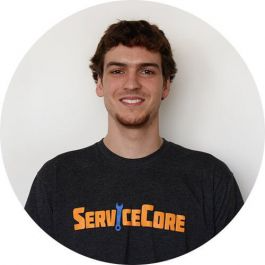
ServiceCore wants to accelerate the commercial liquid waste management industry with its all-in-one platform. The platform helps liquid waste and roll-off rental companies easily manage schedules, routes, customers and inventory in order to save time and maximize profit.
Lead Developer and Scrum Master Andres O’Brien told us how his team keeps sync-ups succinct and informative. Hint: these huddles shouldn’t be used for status updates.
What does a typical sync-up look like for your team?
Our morning standups last anywhere from five to 15 minutes. The scrum master starts with any important updates, then the team takes over from there. There is no order for stand-up attendees, and each person is expected to give meaningful updates if they apply to teammates. We don’t use standups as status updates. Sometimes, it’s OK for nobody to speak (don’t mistake silence for unproductivity). To keep things moving quickly, the scrum master will monitor meeting length and overall engagement and will give hints as to when conversations should be taken offline.
What's one thing you've done to improve the effectiveness of your stand-up meetings?
Keep the meeting between developers; let it be theirs. If stakeholders want to join, they are more than welcome to, but they shouldn’t try to take control of the meeting and should be respectful of everyone’s time.
Stop looking for status updates and start looking for problems.”
What's one strategy you’ve found to be critical for keeping employees engaged throughout these meetings?
Stop looking for status updates and start looking for problems. If there are none, end the meeting. It also helps that our developers have a good relationship with one another and are not afraid to speak up and get help if they need it.
ENGAGE
Sean Eby
VICE PRESIDENT OF ENGINEERING

ENGAGE aims to revolutionize the way oil and gas companies interact with their service providers. Its digital field management platform collects data from the edge, such as GPS information and timestamped route and work times, thus offering companies full transparency into their field operations.
Vice President of Engineering Sean Eby said it’s important to leave room for fun during his team’s sync-ups, and encourages teammates to share what they did during their non-working hours.
What does a typical sync-up look like for your team?
We have four types of team meetings, which keep the team connected with one another and updated on our product development. Daily standups are done asynchronously through Slack at the same time every day. Each team member contributes a brief 1-3 sentence snapshot of what they’ve accomplished since the last standup and what they’re aiming to get done in the next 24 hours, along with any questions about challenges they’re running into that someone else may be able to assist with.
Weekly engineering meetings take place on Monday mornings and focus on ongoing and upcoming items that affect our development teams, new hires, organizational changes or announcements within engineering. They also cover technical topics and challenges relevant to our group and what our plan is to change or solve them.
Bi-weekly sprint grooming/planning meetings are part of our Agile process and are meant to keep our product and engineering teams aligned regarding the specifics of our product plan. This meeting also allows the engineering team to provide their own estimates of upcoming work. In some cases, work is being done for a specific customer, and the meeting offers the chance for our team to detail our effort estimate before committing to work being done and charging the appropriate amount of money to a contract.
Monthly all-hands meetings are fun and casual. They serve as organization-wide updates led by our CEO. These meetings bring our distributed team together either in-person or through Zoom, so everyone can see our revenue, customer and organizational updates, ask questions and get caught up on other things.
The written (rather than spoken) format has worked well for us as a distributed engineering team.”
What's one thing you've done to improve the effectiveness of your stand-up meetings?
Undoubtedly, the written (rather than spoken) format has worked well for us as a distributed engineering team operating across different time zones and locations. I realize a text-based format is not the format recommended by many Agile rule-followers, but this format has worked quite well for us. In one way, since it is done through Slack, it provides a historical record of the team’s standups. This makes it easy to go back and look at what happened when, for example, a team member was stuck on a user story for so many days in a row without meaningful progress. The whole team can see this and step in, inquire, offer help or intervene if needed.
Since the standup is “public,” it can be shared or seen by others outside of the team. We sometimes receive questions about what our team does, and showing someone the daily stand-up record is a great way to show what the engineering team gets done at a granular level rather than looking at a sprint board or product backlog.
What's one strategy you've found to be critical for keeping employees engaged throughout these meetings?
We prefer not to have meetings that have a singular purpose. In fact, we have pretty much cut out meetings that are not truly necessary. Even though we have trimmed our meetings as much as possible, we keep things fun by casually checking up on what folks did in their off hours. As a team, we periodically share a laugh about things that happened to us or hard lessons learned along the way.
Fabric
Scotty Eckenthal
ENGINEERING MANAGER

Becoming a parent is a huge financial responsibility. Fabric wants to make things easier for parents. Through their app, parents can organize their family’s important financial and legal information — all in one place.
Engineering Manager Scotty Eckenthal described the benefits of asynchronous discussion and how his team brings joy into everyday sync-ups.
What does a typical sync-up look like for your team, and how do you structure those meetings to ensure they're as productive as possible?
We run a daily standup Monday through Friday with a fairly typical format that consists of updates, intentions and blockers, all pertaining to our team’s weekly goals and quarterly OKRs. We maintain a meeting log in which we note any necessary follow-up discussions. Prior to going remote, we would then break and allow folks to continue their day, expecting that discussion would occur when the opportunity arose naturally in the office. Now, we transition directly into the “parking lot,” which serves as both a structured discussion with agenda items logged during standup and an opportunity for free flow conversation, similar to what we might have experienced walking back to our desks at this time last year. The approach to the parking lot has evolved organically in the remote world and allows us to solve problems efficiently and creatively. Members of our team can rely on that time for sync discussion with their teammates.
What's one thing you've done to improve the effectiveness of your stand-up meetings? What were the results?
While our parking lot is incredibly valuable, we found that, given its lack of structure, it was very easy to lose focus and efficiency in that time when conversation wandered. Several of our team members surfaced this in a retro, and we decided to subscribe (aggressively at first) to an “async-first” philosophy that prefers discussion in Slack over sync discussion in a meeting. We’ve since deliberately identified items in the parking lot that we could try to handle asynchronously, increasing the efficiency of the discussion. We then have those conversations in Slack, which memorializes the discussion for archival purposes and makes for easier transitions into whatever they materialize, such as Jira tickets and RFCs. If we find that async discussion isn’t working for a particular topic, we’ll find the time to discuss synchronously and then return to the Slack thread with the outcome to maintain the pattern.
It is extremely important to our team that everyone knows what we’re trying to accomplish, why it will drive results for the business and how we intend to get there. We’re currently in the middle of a quarterly planning period, during which time teams score OKRs from the previous quarter and define OKRs for the upcoming quarter, and we’re prioritizing the visibility and measurability of our team’s progress toward these goals. In addition to these tactics, we’re identifying metrics we can use to chart our progress over the course of the quarter and designing an analytics dashboard to manifest that progress visually. We hope to use this dashboard in our regular Agile planning meetings, including standups, to make sure we’re on the right track.
We found that if we didn’t bend our rules a little bit, we’d lose track of who we were as people.”
What's one strategy you've found to be critical for keeping employees engaged throughout these meetings?
When we went remote, we deliberately shifted from “starting immediately on time” to taking the first few minutes of our daily standup to catch up together organically. This sort of discussion would occur naturally in our office, but we found that if we didn’t bend our rules a little bit, we’d lose track of who we were as people, which in turn would inhibit our ability to work together effectively.
Fun is essential for me in a work environment. In fact, members of the team joke that my management style is “camp counselor,” and they’re not that far off base. Joy is one of Fabric’s core values, so I’m really thankful to be around folks who feel similarly and not only tolerate my antics but feed back into them. I can’t say that we do anything specific other than prioritize each other’s needs as human beings during this time, but it has certainly paid off. For one thing, it makes for an easy and deliberate transition when the time comes to focus, but for another, it brings our team together. Since we started, the group has naturally expanded, as key subject matter experts and contributors outside of our immediate team wanted in on the fun. As a result, that larger group has more opportunities to connect and cross-pollinate as we work together toward our larger goals.
CLEAR
Dave Proskin
ENGINEERING MANAGER, MOBILE
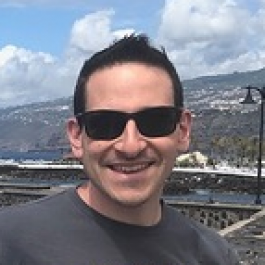
Traditional ID documents can be a hassle. That’s why CLEAR has developed biometrics screening technology that registers people’s eyes and face to confirm their identity. CLEAR’s touchless ID is currently being used at airports, sports stadiums and other high-density locations.
Engineering Manager Dave Proskin shared how he helps his team members feel connected during sync-ups and why they rely on “posts” to make meetings more efficient.
What does a typical sync-up look like for your team, and how do you structure those meetings to ensure they're as productive as possible?
Our standups have two goals: bring the team together face to face, which in the current climate is more important than ever, and ensure that anything blocking the team from making progress is identified quickly. One thing we do that helps the team feel connected is ask everyone to put their cameras on if they are comfortable doing so. Seeing other team members' faces (and sometimes fun virtual backgrounds) goes a long way and helps increase engagement during the call.
We have a designated team member — in our case, our program manager — who runs the meeting and calls on each team member for their update. We try to keep the discussion focused on the speaker’s tickets so we’re staying focused on delivering the objectives in front of us. Finally, any topic that is going to consume more time is handled via a “post” at the end to let anyone who doesn’t need to join that discussion drop off and get on with their day.
What's one thing you've done to improve the effectiveness of your stand-up meetings? What were the results?
Having a designated team member who runs the meeting and calls on each member definitely speeds up the flow of the meeting and makes sure no one gets skipped. Before we did that, it was a guessing game on who should speak next and who had already gone, with lots of awkward pauses. Even with our growing mobile team at CLEAR, we’re still able to get through the daily standup in around 15 to 20 minutes most days.
I’ve found that, in general, meetings are only repetitive or boring for team members when they feel they’re not relevant.”
What's one strategy you've found to be critical for keeping employees engaged throughout these meetings?
In the current climate, there’s sometimes a feeling of meeting overload. While we could have more casual conversations together in an office before, now we have to make time in our schedule to ensure things are effectively communicated. But as fewer and fewer teams operate in a truly collocated fashion, developing the skills to run a distributed team is critical.
I’ve found that, in general, meetings are only repetitive or boring for team members when they feel they’re not relevant. During our standups, there’s nearly always some question raised, context that someone is sharing or a call for help from one team member to another, which helps contribute to the feeling that it’s important to join the standup. Oftentimes, we iron out critical details during our posts, which help ensure we’re not bouncing too much back and forth in Slack. Variety is definitely useful. Every now and then, we inject a fun topic that we ask each member to address, such as what their favorite flavor of coffee is (and don’t you dare say you don’t drink coffee).
Mulberry Technology
Lee Johnson
CHIEF TECHNOLOGY OFFICER

For e-commerce businesses, offering product protection to customers is a top priority. Mulberry Technology wants to make this easier. Using APIs and AI, the company helps businesses create personalized product protection solutions that unlock additional revenue and increase brand loyalty.
Chief Technology Officer Lee Johnson told us why they decided to split each sync-up into a series of smaller meetings and what they’ve done to keep them more focused.
What does a typical sync-up look like for your team, and how do you structure those meetings to ensure they're as productive as possible?
We have daily standups here at Mulberry. Since we’re remote, we’ll typically gather on a Google Hangout at 10:30 a.m. You’ll often see at least one front-end and back-end engineer, a product manager, a product designer and a data scientist on the call. We’ll each talk a bit about current statuses on ongoing projects, then we’ll shift to what’s next on the docket for us. It’s also a good time to raise any complicated issues or dependencies we’re facing. A different person on the team kicks the meeting off each day, and each participant chooses who speaks next.
What's one thing you've done to improve the effectiveness of your stand-up meetings? What were the results?
We recently split up our monolithic team standup into a series of smaller standups, which own specific areas of the product. This has been incredibly impactful and has fostered a stronger sense of ownership, innovation, productivity and quality amongst the smaller teams.
Our standups have become much more relevant to everyone involved, which has significantly boosted engagement and team communication overall.”
What's one strategy you've found to be critical for keeping employees engaged throughout these meetings?
Now that everyone is working within set pods on a specific segment of the product, our standups have become much more relevant to everyone involved, which has significantly boosted engagement and team communication overall. Additionally, we’ve done a much better job at moving more in-depth, tactical discussions that arise into “offline,” separate meetings to keep our standups more focused and efficient.
Frame.io
Michael Angelo
ENGINEERING MANAGER

For creative teams, keeping videos, images and other assets in one place is important. That’s why Frame.io has created a platform that helps them do just that. Through their collaborative platform, teams can view feedback, illustrate their ideas and get comments and approvals in real time — from anywhere in the world.
Engineering Manager Michael Angelo discussed why his team cut their sync-up meeting times in half and how each team member gets the chance to take ownership of sync-ups.
What does a typical sync-up look like for your team, and how do you structure those meetings to ensure they're as productive as possible?
Our typical sync-up is our daily standup, which includes product, design and engineering. It is a time for the team to share, specifically, what they did yesterday, what they are working on today and if they have any blockers. The goal is simple: We want our teammates to be updated on current work and potential concerns, all while enhancing communication and visibility.
What's one thing you've done to improve the effectiveness of your stand-up meetings? What were the results?
Within the last six months, we’ve cut our daily standup time in half from 30 to 15 minutes. This was made possible after we introduced a concept of post items. Essentially, anything that will take longer than 30 seconds to explain or may need deeper discussion is set aside for after the meeting. This allows for an efficient standup and deeper discussion with the necessary people rather than the whole group.
We want our teammates to be updated on current work and potential concerns, all while enhancing communication and visibility.”
What's one strategy you've found to be critical for keeping employees engaged throughout these meetings?
Our team stays involved and engaged by taking turns running our sprint ceremonies, which includes standup, backlog grooming, sprint planning and retro. We all have different personalities, and we want everyone to take ownership and have opportunities for how our team operates. The rotation allows for the team to experience different people at the helm with a variety of viewpoints.
Addepar
Trevor Caira
DIRECTOR OF ENGINEERING

Many wealth management firms lack the tools needed to maintain a competitive edge. In response to this need for improvement, Addepar offers a platform that helps firms consolidate and unify all their data, so they can easily analyze any portfolio and provide clients with a more complete financial picture.
Director of Engineering Trevor Caira shared why he keeps his team sync-ups concise and information-dense.
What does a typical sync-up look like for your team, and how do you structure those meetings to ensure they're as productive as possible?
We run two daily video standups on each coast. The format mirrors an in-person standup meeting. Each update consists of yesterday's progress, today's plans and any blockers. We close out the session with any announcements I might have for the team. In a post-pandemic world, this daily information flow is essential to keeping the team updated on what's going on in the company.
What's one thing you've done to improve the effectiveness of your stand-up meetings? What were the results?
The single thing I've done to improve our standups' efficacy is to focus on the core agenda of updates, plans and blockers. As a result, our standups end on time and are more relevant to the group, and some meetings are pushed offline for related conversations.
We like to keep our stand-up meetings concise and information dense, which staves off some of the repetition.”
What's one strategy you've found to be critical for keeping employees engaged throughout these meetings?
We like to keep our stand-up meetings concise and information dense, which staves off some of the repetition. While most of our time in sync-up meetings is spent in standup, we have managed to make the majority of our team's process asynchronous to mitigate the ceremony and repetition of otherwise formulaic meetings.
Gimbal
Alex Steady
PRODUCT MANAGER

What does a typical sync-up look like for your team?
Our product sync is structured biweekly, aligned a day after each of our engineering teams’ Agile sprints. This structure allows every sync’s timeline to be in cadence with our incremental, feature-driven development. The agenda consists of a roadmap review epic and feature ETA updates, reviewing bugs or tasks created in the last couple of weeks, features released in the last sprint, what the team is currently working on and what we’ll be up to next.
There’s also a Q&A, competitive intelligence and market trend exploration. The sync is intended to get all Gimbal employees up to date with the tech and product team. Conversely, it ensures our product team stays situated within the needs of our various stakeholders. The meeting is recorded, and it, along with associated shared data, is posted in our internal Wiki. Lastly, I send out an email with high-level updates for those that need a “TL;DR.”
I hold a product session at the end of each sync where we go over a hot topic, a future initiative or an existing framework.”
What’s one thing you’ve done to improve the effectiveness of your stand-up meetings?
We start with exciting updates on the roadmap and sharing good personal or professional news instead of beginning with issues like we used to. It allows us to begin with wins and positive dialogue from all colleagues who want to share. Then, we can go into issues and roadblocks that have recently come up, where the conversation can get a bit more involved.
How do you keep employees engaged during sync-up meetings?
I hold a product session at the end of each sync where we go over a hot topic, a future initiative or an existing framework. The session gives internal stakeholders more in-depth knowledge to understand the underlying architecture at Gimbal and can also help with a seller’s go-to-market strategy. For example, a recent product session we led was on iOS 14 and how that affects our business.
We also try to have questions ready for teammates to assess work-related product or market fit and existing prioritization. And we discuss non-work-related subjects, like how the MLB playoff picture will play out or recently binged TV shows.
FloQast
Vinoj Zacharia
ENGINEERING MANAGER

What does a typical sync-up look like for your team?
I look at a morning standup through two lenses: discussing things that can affect someone else and listening to whether team members are blocked or need assistance.
Those two focuses put a structure in place to share the context needed for the team while also creating an environment where anyone can ask for help. Team members are great about offering to put their work aside to help someone else, because it’s core to our culture.
We have a ‘parking lot’ after the standup where people can stay based on a given discussion.”
What’s one thing you’ve done to improve the effectiveness of your stand-up meetings?
It’s totally normal that sometimes people get “status-y” in their updates, sharing details like, “I had my one-on-one with Vinoj, then I got lunch, then I found this really neat npm package…” We are pretty good about cleaning what doesn’t fit our first lens of “things that affect someone else.”
There are other times where there is a topic that affects someone else, but a subset of people need to stay. So we have a “parking lot” after the standup where people can stay based on a given discussion, or leave if it doesn’t affect their work. By keeping these guidelines in place, the standup tends to be focused and effective.
How do you keep employees engaged during sync-up meetings?
All our standups are virtual now, so the Zoom room opens up a bit early most of the time and people will chat about non-work stuff and build camaraderie before we begin. I get going at the meeting time, and by following the steps above, standups typically take about five to 10 minutes. People stay engaged by continually building relationships with each other while also discussing things that matter for the entire group in a short amount of time.
We’re big believers in deep-focus thinking time for engineers — which I like to call “headphones time” — because we see it as the best way to get the right product to our customers. Standups serve as a way to quickly share context to springboard into deep-focus thinking time.
DoubleDown Interactive LLC
Chris Chamberlain
SENIOR PRODUCER MANAGER
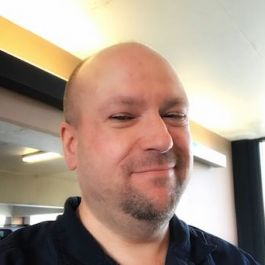
“We have a few different types of syncs focused on different audiences and depth of discussion,” Chris Chamberlain, DoubleDown Interactive senior producer manager, said.
There are a number of sync-up meetings at the casino games company, and each one has an agenda that a producer guides attendees through. However, within those structures, Chamberlain said producers inject their personalities into the meetings to keep attendees engaged.
What does a typical sync-up look like for your team?
Morning team syncs are generally under 15 minutes, feature 20 to 30 people and take place Monday through Thursday. The meetings are the same every day and act as a quick status update on the latest build we’re working to ship. Everyone also quickly shares what they are focused on and if they are blocked. Afterwards, small groups may stick around for an “after party” to discuss topics in more detail that don’t require the full team.
There are also smaller, semi-weekly, feature-specific syncs that have 10 to 15 attendees and run up to 45 minutes. They are focused on building one thing and all disciplines working on the feature can weigh in. Finally, we have a leads meeting where managers and feature leads meet twice per week to share information across disciplines and projects, remove roadblocks and solve problems.
Each of our producers uses their unique personalities to great effect in our various standups.”
What’s one thing you’ve done to improve the effectiveness of your meetings?
We’ve learned a lot about standups in the two years that we’ve been working on our game “DoubleDown: Fort Knox.” Initially, we had long meetings that were open to anyone. Sprint planning our first year dragged the team into a room — sometimes for two hours — and halted development planning. Then we scaled the time and audience appropriately for each meeting. We took longer discussions to “after parties” or different meetings.
Release planning is much more “on call,” where leads call on individual contributors in 15-minute bursts prior to meetings to plan out the work. We try to respect developers’ and content creators’ time, so having a producer drive the meeting helps us stay focused.
How do you keep employees engaged during sync-up meetings?
Each of our producers uses their unique personalities to great effect in our various standups. Daily standups with Charles are short and efficient. Prior or post-standup, he often shares pictures of his daughter or his latest photo-shopped creation. Howard has an endearing personality and thanks his teams often for their work. He also has a dry sense of humor and uses measured sarcasm to crack people up. Jeff — a sharp, certified scrum master — has very efficient standups, but he is quick to respond with jokes as well.
All the producers get to know the people they work with on personal levels and what motivates them, a bit of what’s going on outside of work, etc. That personal touch and humor help to engage our teams and make us feel mutually invested in the success of our work.
Assurance
Chris Wallace
SENIOR SOFTWARE ENGINEER

Rather than having a traditional daily team sync, Senior Software Engineer Chris Wallace said the dev team at Assurance relies on a Slack bot to keep the team members informed on what everyone is working on. Efficiency-improving practices like that and others help developers at the insurance tech company maintain uninterrupted workflows.
What does a typical sync-up look like for your team?
Our team spans three time zones, so our sync-ups often need to stay as asynchronous as possible. Our team adopted a hybrid model where we take advantage of working remotely. We run some meeting components in chat and others in person or over Zoom.
Each morning, a Slack bot from Standuply asks each team member for “stand-up details,” like what they worked on yesterday, the work ahead and any blockers they’re facing. Those details are published on their behalf to our team Slack channel. It gives us insight into what everyone is working on without interrupting the team’s flow. Every week, our team syncs for an hour-long planning session where we do backlog grooming, chat with each other and realign our priorities.
We aggressively try to respect people’s time, which means that our meetings do not run long.”
What’s one thing you’ve done to improve the effectiveness of your meetings?
Our team made three decisions that have drastically improved our sync-up processes. The first is that we keep a Zoom room open constantly for folks to hang out in. The room — called #NeverWorkAlone — gives team members a place to squat and exchange ideas when they pop into their heads. It helps because when our weekly sync-up starts, it’s not the first time we’ve actually talked all week.
Secondly, our team focuses on big project epics, with each area of work assigned to two or more team members. Two people jointly give their update in our big meetings and the other members have a high-level idea of the work actually getting done.
Finally, our team timeboxes everything. We aggressively try to respect people’s time, which means that our meetings do not run long. Timeboxes keep us engaged by preventing the “infinite sprint planning” meeting dreaded by all.
OpenMarket
Dennis Orji
SENIOR TECHNICAL DELIVERY MANAGER

The daily sync-up meetings at mobile marketing company OpenMarket are geared toward speed and efficiency. Senior Technical Delivery Manager Dennis Orji said team members quickly share updates from the last 24 hours with the help of scrum boards. But if they don’t have any updates, they don’t have to share.
What does a typical sync-up look like for your team?
During our daily standup, each team member briefly explains what they did the previous day and their plan for the coming day. Other team members listen carefully to the updates to ensure there are no potential impediments to their tasks. They can identify and suggest potential improvements. The meeting ends with an open floor where anyone could ask for help with their work or flag issues that require the attention of the team.
We encourage team members with no substantial update from the previous day to say they have nothing new to report and skip speaking.”
What’s one thing you’ve done to improve the effectiveness of your meetings?
With working from home in full gear at Openmarket — and the distractions that come with it — we found that displaying our scrum boards a couple of minutes before meetings start allows team members to recollect their thoughts on the work they did the previous day. It’s helped team members provide their updates quickly and accurately.
How do you keep employees engaged during sync-up meetings?
We encourage team members with no substantial update from the previous day to say they have nothing new to report and skip speaking. It removes the presumption that they must say something during the sync meeting. That way our updates are concise, valuable and do not sound like the team member is filibustering.
Shipwell
Nick Fortenberry
ENGINEERING MANAGER

At Shipwell, the key to productive daily sync-ups is efficiency. Engineering Manager Nick Fortenberry said that he and his colleagues push for a strong “video on” culture so that that team feels connected to one another and ready to tackle the day. He and Senior Engineering Manager Harper Maddox often start their sync-ups by sharing a big win, positive customer feedback or by prompting a quick chat about everyone’s weekend.
What does a typical sync-up look like for your team, and how do you structure those meetings to ensure they're as effective as possible?
Fortenberry: In this new pandemic era, Shipwell, like many companies, had to quickly switch to remote working, significantly impacting the way almost all communication was handled. Our daily syncs were largely impacted. In-person communication will always have its advantages, so we’ve tried our hardest to keep a strong and transparent form of communication flowing, especially in our daily syncs.
Each team formats their sync-ups slightly differently depending on the group. However, the general structure is the same. Since these meetings are now all virtual, the team leader will share their screen with the sprint board. This allows for us to get a visual representation of how closely we’re tracking toward completing our sprint goals.
We always answer the three following questions in our meetings: “What did you do yesterday?” “What are you doing today?” and, “Do you have any blockers?” Anything outside of these questions, such as clarity around requirements, are moved to a post sync-up, where the parties who are not invested in the topic can drop off the call.
Harper Maddox
SENIOR ENGINEERING MANAGER
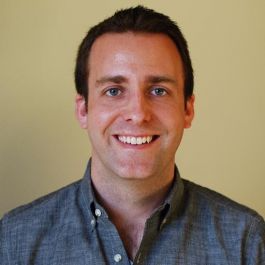
What’s one thing you’ve done to improve the effectiveness of your stand-up meetings?
Maddox: Once we passed the 20 employee mark, our daily standups were taking too long. Even with everyone nonverbally communicating “wrap it up” to our long-winded friends, they tended to drag on for 30 minutes to an hour every day. We were a tight-knit team but that connectedness was costly. A lot of the meeting was just noise. Then Charles Dickerson, our new VP of engineering, came along and rolled out the “squad model.”
The squad model was popularized by Spotify but the core concepts have been around for a long time. Divide your organization into cross-functional teams that combine product and engineering expertise. Squads are nimble enough to wrap up a standup in 10 minutes but robust enough to tackle a quarterly roadmap. They effectively align resources based on business value and can help you reduce inefficiency.
However, unless you put in the effort, squads can easily become siloed. Without communication and paths across the teams, organizational knowledge fades away and you’ll have trouble operating as a cohesive unit. For this reason, we’ve adopted chapter meetings (hard groupings like back end and front end), guild meetings (soft groupings like SRE and API), and rotations across the squads. Still, the downsides are small compared to the gains we received with our sharper focus on product.
Once we passed the 20 employee mark, our daily standups were taking too long.’’
Sync-up meetings can have a tendency to feel repetitive or boring after a while. What’s one strategy you’ve found to be critical for keeping employees engaged throughout these meetings?
Maddox: Many people hate meetings because they can be a waste of time. The time wasted could be better spent coding, adding a couple more unit tests or farming karma on Hacker News. We get annoyed when someone rambles about some niche topic that we never interact with and don’t find interesting. So the first trick is not to go on a diatribe about the chain of events that led to broken search indices on the dev environment. We have a term for this on the internet: “TL;DR.”
Next, move all discussion to the end of the standup. Doing so allows the group to get to the point of the meeting immediately. Often, the whole team will log on as we discuss a few key topics and then those interested in a deeper dive will stay. Those are the people who want to know the root cause of the outage or are curious as to why Svelte is the new hotness.
Bright Health
Zheng Zhu
VP OF DATA ENGINEERING

“I had an appointment yesterday so I didn’t get to do much work.”
According to VP of Data Engineering Zheng Zhu, this is a common refrain heard in meetings that are designed around traditional frameworks. That’s why at Bright Health, engineers rely on Kanban visualization boards for sync-ups. When the team’s focus is on the board, he’s found that it’s less likely they’ll be distracted by such side comments.
What does a typical sync-up look like for your team?
Sync-ups should occur daily and be focused on helping the team make progress on the work at hand. Because our teams are now remote, we have everyone turn on their webcams. Doing so helps remind our teams that we are still working alongside our peers and that nothing has changed about our relationships. Visual feedback helps bring out emotional nuance of conversations, which is key to clear communication.
Sync-ups should typically take around 15 minutes. That way, you have enough room to go over issues pertaining to a two-pizza-sized team and aren’t left with time for unrelated or detailed side discussions. Lastly, have the person leading the standup share their screen. This tool takes the place of a whiteboard. It ensures that everyone is focused on the same thing.
Visual feedback helps bring out emotional nuance of conversations.’’
What’s one thing you’ve done to improve the effectiveness of your stand-up meetings?
A commonly used framework is to have everyone on the team go over the following questions: What did I work on yesterday? What am I working on today? What issues are blocking me?
Our engineering teams at Bright Health have shifted toward a different approach. We focus on the Kanban board, letting that approach drive the flow of statuses and conversation. Specifically, we start from the right side of the visualization board, which contains items that are nearing completion in our Agile flow. The idea is that, as a team, we should swarm around unblocking and completing those first so that we achieve value from our work sooner rather than later.
That said, engineers who have already completed their sprint work aren’t represented with this approach. However, the Agile process itself can address this type of loophole. There should be a well-groomed backlog and a clearly communicated process to pull from when an engineer has no tickets on the board. Our engineering teams that have adopted this strategy have seen a general increase in our feature cycle time and value delivery for our stakeholders, leveraging the time allotted for these meetings more effectively.
What’s one strategy you’ve found to be critical for keeping employees engaged throughout these meetings?
With concerted focus on the work at hand, we typically have high levels of engagement in these meetings. The repetitiveness is not a challenge because the work continues to change daily and from meeting to meeting. We try to create a strong sense among attendees that we are working as a cohesive team toward clear goals.
Because everyone takes turns discussing issues on the board, there’s typically little opportunity for someone to become or stay unengaged. Lastly, when there’s a list of next steps being populated in real time during the discussion, vigilance is key.
H-E-B
Lacy Llana
TECHNICAL PROJECT MANAGER
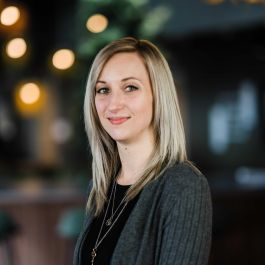
At H-E-B, engineers assign “time trolls” to each sprint so that everyone stays on course. Technical Project Manager Lacy Llana said that it’s helped keep team members aware of and ready for what’s next. But at the end of the day, there’s no one-size-fits-all approach to any meeting, Agile or not.
Her theory? Let the team dictate the format that works best for them.
What does a typical sync-up look like for your team?
Each morning, we walk through our team’s Jira board, filtering by team member. Each person gives an update on what they worked on the day before, what they plan on working on that day, and brings any blockers to the team’s attention. We focus on those points and if we start “solutioning” too in depth, we pause and take note that we need a parking-lot discussion for that topic.
Since going remote, we spin off parking-lot Zoom calls and share the links in Slack for anyone who needs to be involved to join. We also elect a “time troll” each sprint to give us warnings as we approach our meeting end time.
We elect a ‘time troll’ each sprint to give us warnings as we approach our meeting end time.’’
What’s one thing you’ve done to improve the effectiveness of your stand-up meetings?
Initially, we were not using Jira during standups. During the meeting, team members would have to try to remember everything they were working on, which is a struggle first thing in the morning, and the conversations tended to get off topic. At the end of our sprints, we saw a mad dash to update tickets and a potential for tickets to get overlooked or even go uncreated if the work was unplanned.
Using our Jira board to structure our standup has made for a more streamlined sync and better understanding of the work in flight.
What’s one strategy you’ve found to be critical for keeping employees engaged throughout these meetings?
Aside from keeping the meeting on track and moving quickly, I believe the most important thing in keeping a team engaged is to reinforce the idea that the process belongs to them. The standup I’ve described above isn’t a one-size-fits-all solution.
Team members should feel empowered to say, “These meetings aren’t effective or beneficial,” and to help continuously approve the format. Creating a space where team members feel safe to share their ideas or concerns is key to building not just an effective sync-up but also a high-performing team.
SpyCloud
Ronak Patel
VICE PRESIDENT OF ENGINEERING

At SpyCloud, meetings haven’t lost their personal touch since the team went remote last spring. Vice President of Engineering Ronak Patel said he relies on a lot of documentation and a little bit of fun to keep everyone headed in the same direction –– sometimes even encouraging other departments to join.
What does a typical sync-up look like for your team?
Since March, the SpyCloud engineering team has been working remotely. While we’ve made minor adjustments, our remote standups look and feel a lot like our in-person meetings, with intention on focus, inclusion and documentation. In order to keep our time together productive, we circulate an agenda beforehand. We rotate who leads the standup so we stay on track and have someone take notes.
It seems obvious, but these points have become doubly important now that we find ourselves in more meetings. We need to be even more efficient with our time.
What’s one thing you’ve done to improve the effectiveness of your stand-up meetings?
Documenting everything is the key to successful remote teams. We are more effective because we’re diligent with taking and distributing meeting notes and action items. We also capture task status in Jira and chat over Wire, our collaboration tool. Communication is key!
We leave time for watercooler talk, which is important since we don’t get to see each other in person.’’
What’s one strategy you’ve found to be critical for keeping employees engaged throughout these meetings?
We leave time for watercooler talk, which is important since we don’t get to see each other in person. We also added tech demos. We invite people from other parts of the organization to join our standups so we stay connected and engaged with the rest of the company (and vice versa). Outside of standups, we make time for socializing over video games or cracking each other up over a quick game of skribbl.io.
LogicMonitor
Peter Stradinger
FRONTEND TEAM LEAD
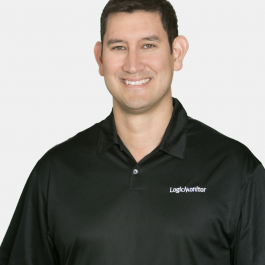
At LogicMonitor, Frontend Team Lead Peter Stradinger said senior engineers help junior engineers adjust to deadlines by separating larger projects into more manageable pieces. He credits end-of-day demos, where peers share the details of certain individual projects with one another, with the focus and excitement he’s used to seeing on faces across his screen.
What does a typical sync-up look like for your team?
Since COVID-19 has us working from home, we’ve restructured our meetings to help provide a more office-like environment. We hold a quick meeting at an agreed-upon time every day, first thing in the morning. It gets us out of bed and engaged with what we’re about to do. The meeting is partly to say “hello” to each other and partly to coordinate around who is working on what. Each person supplies a falsifiable target for what they’d like to demo at the end of the day. It needs to be a small, achievable, concrete thing. We look at our calendars while doing it, so we take into account any meetings, personal appointments and lunch plans, as well as how big our blocks of time are. We also use this meeting to coordinate whether we want to pair with others. I record the targets that each person in the team states.
We end our days with a 15-minute meeting as well. It’s paramount that we have effective boundaries in order to keep work-life balance reasonable. I have a hard rule that nobody works after the demo until the coffee/tea meeting the next day. Working extra is not socially rewarded.
If someone doesn’t hit their target, we kindly talk it through and try to understand what happened. Often we discover that there was an external blocker that slowed us down. When we uncover those things, we write them down and remember them for retrospective. That way, we can factor those blockers into our coffee/tea discussions when we’re developing future targets. We've found that if we’ve structured our work well, we tend to have impressive demos about every other day. It’s a very high-energy meeting and it makes the team feel good about what they’ve done.
What’s one thing you’ve done to improve the effectiveness of your stand-up meetings?
Honing in on what will be demoed at the end of the day really focuses people. If you’re working on a specific project for four days, you need to make a plan for what you can show for each of those four days. There are different ways of planning complex tasks, and it enables the more experienced team members to help the more junior ones get oriented on how to set useful milestones.
We’ve had surprisingly few slippages since we implemented this. A dev can only drift down an obviously bad path for at most one day.
When you see your peers demoing cool things, it makes you want to do the same.’’
What’s one strategy you’ve found to be critical for keeping employees engaged throughout these meetings?
The demo is key. Thinking about giving status updates is boring and stressful. When you see your peers demoing cool things, it makes you want to do the same. When we all achieve together, we celebrate and leave work feeling happy. We often cheer, back-pat and encourage in the demo meetings.
Once every three weeks, we combine the feedback about our process and have a 30-minute discussion about how we can improve it. The shape and timing of these meetings, along with the firefighter role and the technical design reviews, are all resources that have come out of retrospectives.
AffiniPay
Heather Hull
TECHNICAL PROGRAM MANAGER

Technical Program Manager Heather Hull tries to ensure that during daily sync-ups at AffiniPay, everyone speaks for around the same amount of time. That way, no one feels bulldozed or taken for granted. In an effort to keep meetings on track, Hull said she saves side topics for the end of the huddle so people with an urgent task or long to-do list can drop out when necessary.
What does a typical sync-up look like for your team?
In our daily standup, each team member talks about what’s changed since the day prior, what’s planned for that day and whether anything is blocking their work. The focus is on whether our project is progressing as expected. We try to make these meetings short and leave the in-depth problem solving to another time.
What’s one thing you’ve done to improve the effectiveness of your stand-up meetings?
The key to our success is the relationships our team members have with one another. Now that we’re working remotely, we try to make sure everyone’s camera is on so we can better connect. I think that’s been a key to maintaining the trust and friendships we had already established when we all worked together in the office. We also work to provide an open and transparent atmosphere so everyone feels comfortable speaking their mind. Everything is on the table and everyone is encouraged to participate at whatever level they are comfortable with.
The key to our success is the relationships our team members have with one another.’’
What’s one strategy you’ve found to be critical for keeping employees engaged throughout these meetings?
We try to keep our standup as short and focused as possible. Ideally, we save side topics for the end of the meeting so people can drop out when necessary. We also frequently discuss milestones that are a bit farther out in the future and make sure everyone understands the larger goals we have in mind. We don’t just focus on the current sprint.
Pushnami
Mitchell Taylor
VP OF SOFTWARE DEVELOPMENT

Once the team went remote, Pushnami VP of Software Development Mitchell Taylor said he discovered that incorporating a “popcorn”-style approach to passing the verbal baton during sync-ups keeps developers alert and involved. As a result, the 10-minute daily meetings feel productive and engaging.
What does a typical sync-up look like for your team?
We meet for our standups at the same time each morning and each member delivers an update about what we worked on the previous day, what we plan to work on, roadblocks, etc. Keeping a target time limit is critical to maintaining an efficient and productive standup.
Keeping a target time limit is critical to maintaining an efficient and productive standup.’’
What’s one thing you’ve done to improve the effectiveness of your stand-up meetings?
Working remotely has introduced some changes to the way we hold meetings. With most members calling in, we noticed our stand-up meetings started to lose some of the natural cadence we had standing in a circle. As an alternative approach to a single stand-up facilitator, we ran several standups where each member would call out another who has not yet delivered an update. This approach seemed to encourage more engagement between members and form a more active discussion on how we plan to meet the goals of the day as a team.
What’s one strategy you’ve found to be critical for keeping employees engaged throughout these meetings?
Having an ice-breaker can be a quick way to boost engagement and energy in our morning meetings. It can also be a useful way to set the tone for the meeting and the rest of the day. At the start of our standup, we typically do a quick review of which projects are ongoing, recent achievements and milestones.
Vestmark, Inc.
Bobby Lough
ENGINEERING DIRECTOR / AGILE COACH

Vestmark aims to make life easier for those involved with wealth management. The company’s SaaS ecosystem enables financial advisors and institutions to manage and trade their clients’ portfolios.
Engineering Director and Agile Coach Bobby Lough discussed how his team of “scrum purists” benefits from setting goals and keeping sync-ups short and structured.
What does a typical sync-up look like for your team, and how do you structure those meetings to ensure they're as productive as possible?
Vestmark's teams are made up of “scrum purists,” so our daily scrums occur at the same time each day and respect a 15-minute timebox. While people are joining the meeting, we keep it light with friendly banter mostly regarding stuff outside of work. A little positive energy can go a long way. This has become especially important during the pandemic because we are not co-located. However, once the meeting starts, people are committed to recapping the past day and planning the coming day.
During the daily scrum, each person on the team answers the three standard questions before picking another team member to provide their update. The team is encouraged to ask each other questions so they can unite to overcome whatever challenges come their way. If any update or a line of questions gets too deep into the weeds, someone on the team says "elmo" (enough let's move on) to move that conversation to the “parking lot,” where it can be discussed after all team members have provided an update. Adhering to this structure keeps our daily scrums succinct and impactful.
What's one thing you've done to improve the effectiveness of your stand-up meetings?
We have found that it’s important to set the stage. A daily scrum can quickly devolve into a status meeting, in which team members attempt to justify what they did to earn their paycheck yesterday and how they intend to earn it today. When daily scrums become status meetings, people tune out and just wait for their turn to talk. To counteract that, our scrum masters open the first daily scrum of the sprint with a quick reminder of the purpose of the meeting, the scrum values (courage, focus, commitment, respect and openness) and meeting norms, as well as the sprint goal and the value it can bring to each person in the meeting. Those points, as well as the three questions, are included in the recurring meeting invite, so the “what” and “why” of the daily scrum is top of mind. This has helped teams at Vestmark maintain focus and find each daily scrum beneficial.
A little positive energy can go a long way.”
What's one strategy you've found to be critical for keeping employees engaged throughout these meetings?
To add a unique element to each daily Scrum, I encourage teams at Vestmark to set a goal for the day. The previous day's goal is mentioned at the start of the sync-up to provide a foundation for people's updates. Then, after each team member has provided an update, the team collaborates to determine what they want to complete for the next daily scrum.
The goals provide a focal point for the team to rally around throughout the day. Discussing yesterday's accomplishments energizes the team and allows everyone to visualize how they want to accomplish today's goal. The practice of setting a daily goal provides a value-driven artifact of that planning, which emboldens the team to seize the day. Daily scrums are an opportunity for the team to observe where they are at, orient themselves toward a shared objective and decide what action to take over the coming day. Our daily scrums do not feel repetitive or boring to the team because they have become so valuable.
VMware Carbon Black
Alka Deshpande
SOFTWARE DEVELOPMENT MANAGER

According to reports, cyber criminals are projected to steal an estimated 33 billion records in 2023. That’s why VMware Carbon Black was founded. The company specializes in cloud-native endpoint protection, helping large organizations protect themselves against cyber attacks.
Software Development Manager Alka Deshpande told us why he prepares for each sync-up beforehand and how his teammates connect during these meetings.
What does a typical sync-up look like for your team, and how do you structure those meetings to ensure they're as productive as possible?
Daily sync-up meetings are quite fun for my teams. We reserve a half-hour window for these meetings. The meetings are run on Zoom with the video feature turned on. The first 10 to 15 minutes of our meetings allow everyone to share what they worked on the day before, what they plan to work on the day of the meeting and if they have anything blocking them from making progress. As an engineering manager, my job is to make sure that I address any blocker issues so my team can successfully complete their work.
Fifteen minutes prior to the daily sync-up, the scrum master asks for “parking lot” items in a designated Slack channel. The parking lot items are topics that take more time to discuss and are addressed after the status discussion. If more time is required, the parking lot items are discussed in a separate meeting.
Besides working on software development, we also make sure our production systems are functioning efficiently every day. Any production issues for the previous day are discussed in this meeting as well. Our work items are planned out in a Jira board. We also meet once a week to groom our upcoming work items.
What's one thing you've done to improve the effectiveness of your stand-up meetings?
I make sure that I am well prepared for standups. I also make sure that our Jira boards are updated at all times. Everyone’s time must be used very efficiently. Team spirit and collaboration are crucial for the success of these meetings. We use Zoom and share the Jira board on the screen. Everyone in the team gets to speak, voice their concerns and share their successes.
This has enabled us to deliver high-quality software on time for our customers.
Sync-up meetings are about more than just work. We connect as a team during these meetings.”
What's one strategy you've found to be critical for keeping employees engaged throughout these meetings?
We do briefly talk about how everyone is doing. We share pictures of hiking trips and fun activities that folks have recently done. We support each other if someone is going through difficult times. Sync-up meetings are about more than just work. We connect as a team during these meetings. I also provide key information about organizational news during our sync-ups. This way, our daily sync-ups don’t become boring.
Flywire
Eric Spear
SENIOR VICE PRESIDENT OF ENGINEERING

Flywire wants to make cross-border payments as seamless as possible. The company’s platform allows for fast and secure international payment processing, featuring competitive exchange rates, fraud prevention and 24/7 multilingual support.
Senior Vice President Eric Spear shared why his team prefers consistent sync-ups and how they use problem statements to sharpen the focus of their meetings.
What does a typical sync-up look like for your team, and how do you structure those meetings to ensure they're as productive as possible?
My general philosophy around update-oriented meetings like standups is that they must have a degree of consistency. Having them at the same time with the same members creates the foundation for a safe space that allows everyone to talk about the good and bad. The next piece of advice is to have an agenda so everyone can prepare for each sync-up. In my opinion, a standup is not meant for reading off a list of things to do but instead serves as a space to solve problems and empower teams. Lastly, as a leader, you need to be genuine. For me, I like my engineering team meetings to have a lighthearted tone, which makes it more comfortable while also allowing for lane changes when we need to address a serious topic.
What's one thing you've done to improve the effectiveness of your stand-up meetings?
The one thing I have done with my team regarding standups is that I have taught each participant how to write a problem statement. Problem statements tend to be used by management consultants for effective communication to address a specific topic. It’s amazing when you empower team members with this simple tool. It sharpens the focus of the meeting, allowing everyone to share a common goal and yield a solution.
A standup is not meant for reading off a list of things to do but instead serves as a space to solve problems and empower teams.”
What's one strategy you've found to be critical for keeping employees engaged throughout these meetings?
Always keep the meeting dynamic. Assign the agenda of the meeting to various people on the team each week. By giving others responsibility for the meeting, they can get out of their comfort zone with an added benefit while tailoring the meeting so it can evolve and provide more value.
OneView Commerce
Jen Fowler
CERTIFIED SCRUM MASTER PSM I
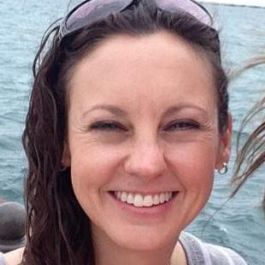
OneView Commerce seeks to “pioneer digital transformation in retail” with its API-first, headless transaction engine. The company’s platform allows retailers to build POS, commerce and digital experiences quickly while reducing regret spend and increasing speed to market.
Certified Scrum Master Jen Fowler told us about the importance of time management and how her team keeps their Zoom cameras on during sync-ups to connect with each other.
What does a typical sync-up look like for your team, and how do you structure those meetings to ensure they're as productive as possible?
Our daily sync-ups serve as quick meetings that allow all team members to highlight current work, discuss what they’re working on next and raise awareness about any impediments, which is crucial. One critical aspect of the sync-up is to review specific deadlines and reminders about important meetings while reinforcing scrum practices to ensure we are working on continuous improvement. All our scrum leaders engage right as the session gets started by finding out how the team is doing, mentioning current events and sharing anything else that gets people involved and ready to participate.
The goal is for teams to own their empowerment both in and out of the standup.”
What's one thing you've done to improve the effectiveness of your stand-up meetings?
We practice a stronger adherence to both starting and ending on time. Time management helps the team get through the standup faster and reduces the distraction from conversations that would be better as one-on-one discussions. Our scrum masters coach teams to self-organize and take the lead to move problem-solving out of the standup and into their own more effective, developer-driven sessions. Our scrum leaders share how effective coaching that is efficiently delivered is critical in today's disrupted environment. The goal is for teams to own their empowerment both in and out of the standup.
What's one strategy you've found to be critical for keeping employees engaged throughout these meetings?
We usually have cameras on at the start so everyone shows up present and engaged, which is helpful when someone is coming from being heads-down in their work. From there, we try to keep it light. We joke around with each other, keeping things interesting and fresh. Candid Zoom shots and banter shared on the call or in team chats keep a sense of humor at the forefront and help make sure that things stay interesting. Most importantly, our teams are fully committed to shared responsibility. This commitment keeps everyone more engaged, both during sync-ups and elsewhere.
Piaggio Fast Forward
Arthur LaVita
SOFTWARE ENGINEERING MANAGER

Piaggio Fast Forward is on a mission to “support a sustainable mobility ecology with healthy lifestyles and social connectivity available to all.” The company aims to accomplish this with its lightweight smart vehicles, which are intended to help people move better, further, faster and more enjoyably.
Software Engineering Manager Arthur LaVita discussed how his team splits their sync-ups into segments to optimize teammates’ time and foster engagement.
What does a typical sync-up look like for your team, and how do you structure those meetings to ensure they're as productive as possible?
Like most people, we quickly made a decision to turn our remote sync-ups into video meetings to make them feel as close to the in-office experience as possible. The structure of the sync-ups quickly started to change, as they were the only daily touch points when all 12 team members got together. Meeting participants began to ask technical questions, debate implementation, discuss pull requests or share their past-day interruptions in detail. Creating other opportunities for total team touch points during the day would have negative impacts on progress, but we had to ensure that these daily sync-ups did not turn into unstructured conversations. To remedy this situation, I turned sync-ups into 30-minute meetings, composed of a 12 to 13-minute standard sync and a four-minute team and company update, while the remainder consists of “parking lot” items with open dialogue.
What's one thing you've done to improve the effectiveness of your stand-up meetings?
The parking lot portion has had positive results. The team members have the opportunity to provide a quick status update during the sync portion, and the additional parking lot platform now allows the team to discuss unplanned topics. Each member is allowed to nominate a parking lot item. Members can then break off, and a smaller crew can remain at the sync-up to provide peer assistance. The whole team is present for the sync-up meetings, so it makes for a really quick conversation without the need to constantly carve out windows of time in everyone’s day. Any team member can choose to stay on the video meeting to hear the conversation if the topic is relevant to their work, ensuring the right members are participating in creating solutions.
If you want employees to feel connected, you need to share and provide the balance of technical update with what is moving around them.”
What's one strategy you've found to be critical for keeping employees engaged throughout these meetings?
The four-minute team and company update really has been a huge favorite of the team and has created better attendance for the sync-ups. Without being in the office, people really miss out on the casual conversations about general happenings, staffing opportunities, high-level direction, critical issues being addressed, feedback from cross-functional teams, management decisions and employee milestones and successes. It’s never the same as being in the office, but team members get valuable knowledge and feel more connected to the business. If you want employees to feel connected, you need to share and provide the balance of technical update with what is moving around them.
Quick Base
Armelle Dawson
DIRECTOR OF SOFTWARE ENGINEERING
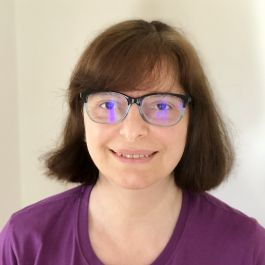
Quick Base aims to help people of all technical backgrounds at businesses of any size improve their processes, gain real-time insights and make better decisions. Their platform enables business and IT teams to safely, securely and sustainably create an ecosystem of applications without the cost of traditional development, maintenance or deployment.
Director of Software Engineering Armelle Dawson told us how she runs sync-ups with a globally distributed team and how consistency keeps her team’s huddles short and effective.
What does a typical sync-up look like for your team, and how do you structure those meetings to ensure they're as productive as possible?
The core platform team’s daily sync-ups are at 9 a.m. Eastern time. The team is scattered across several locations, with one engineer and the team coach located in the Boston area, one fully remote engineer based in New Mexico, two engineers out of the Bulgaria office and a product owner working out of Seattle. The time works well for the team, as it is first thing in the morning for the U.S. team members and early afternoon in Bulgaria. All team members have their video on for the duration of the meeting, which helps teammates connect with each other. To help with any background noises, all other team members go on mute while someone is talking.
We get to a plan of action quickly before moving onto the next person. This ensures our daily sync-up is short and effective in unblocking everyone.”
What's one thing you've done to improve the effectiveness of your stand-up meetings?
During the sync, everyone’s turn is always the same, as we go in alphabetical order. Running sync-ups in the same order ensures a smooth transition from one person to the next. During a team member’s turn, we focus on any questions or impediments to the work in progress. We get to a plan of action quickly before moving onto the next person. This ensures our daily sync-up is short and effective in unblocking everyone. Because the team is small, most days we cover everything in about 15 to 20 minutes.
What's one strategy you've found to be critical for keeping employees engaged throughout these meetings?
At the beginning of the sync-up, we often have a couple of minutes while everyone is getting on Zoom. We take this time to check in on each other on a personal level. After everyone has taken their turn, they then share any information relevant to the team. This includes updates on the business impact of what the team is working on and engineering organization news. This ensures everyone is aware of important information across the company and our department.
Wellframe
Vidya Sambasivan
SOFTWARE ENGINEERING MANAGER

Wellframe wants to “reimagine healthcare relationships” by helping healthcare organizations support their patients more effectively. The company uses tech to deliver the high-touch support people need, offering a suite of digital health management solutions for care management, advocacy and navigation.
Software Engineering Manager Vidya Sambasivan told us why his team members take turns leading each sync-up and how they improve engagement during those meetings.
What does a typical sync-up look like for your team, and how do you structure those meetings to ensure they're as productive as possible?
We do daily standup meetings to sync as a team. Due to COVID-19, we have moved all our standups to Google Meet video calls. We have team members logging in from different time zones during our meetings.
We try to structure our standup meetings around three things: what we have worked on since the last time we met, what we plan to work on until we meet the next time and any blockers. We try to stick to a 15-minute standup as much as possible. Any items that need longer discussions are noted and scheduled for a later time.
What's one thing you've done to improve the effectiveness of your stand-up meetings?
One thing that has improved the running of standup meetings is that we take turns being the scrum master and leading each sync-up. This keeps everyone awake and cuts down on repetition. This also gives more opportunity for various team members to be in leadership roles.
Asking for input from the team during stand-up meetings has improved engagement within the team and helps others who may not always voice their opinion have a chance to speak.”
What's one strategy you've found to be critical for keeping employees engaged throughout these meetings?
Team engagement is very important, especially when we follow a standard agenda in stand-up meetings. Asking for input from the team during stand-up meetings has improved engagement within the team and helps others who may not always voice their opinion have a chance to speak.




